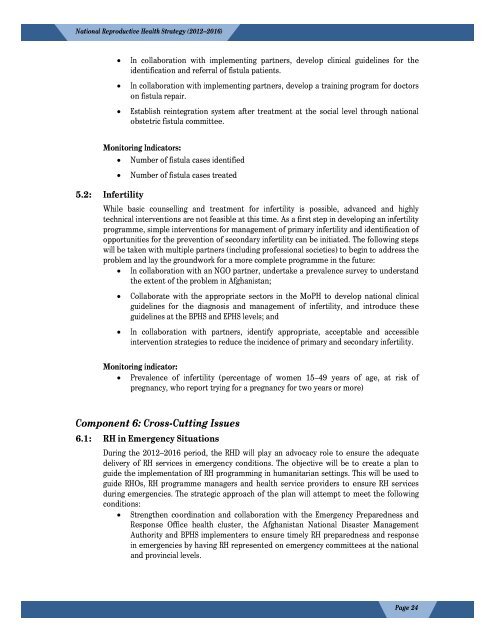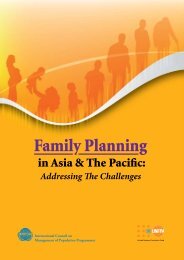national reproductive health strategy - Ministry of Public Health ...
national reproductive health strategy - Ministry of Public Health ...
national reproductive health strategy - Ministry of Public Health ...
You also want an ePaper? Increase the reach of your titles
YUMPU automatically turns print PDFs into web optimized ePapers that Google loves.
National Reproductive <strong>Health</strong> Strategy (2012–2016)In collaboration with implementing partners, develop clinical guidelines for theidentification and referral <strong>of</strong> fistula patients.In collaboration with implementing partners, develop a training program for doctorson fistula repair.Establish reintegration system after treatment at the social level through <strong>national</strong>obstetric fistula committee.Monitoring Indicators:5.2: InfertilityNumber <strong>of</strong> fistula cases identifiedNumber <strong>of</strong> fistula cases treatedWhile basic counselling and treatment for infertility is possible, advanced and highlytechnical interventions are not feasible at this time. As a first step in developing an infertilityprogramme, simple interventions for management <strong>of</strong> primary infertility and identification <strong>of</strong>opportunities for the prevention <strong>of</strong> secondary infertility can be initiated. The following stepswill be taken with multiple partners (including pr<strong>of</strong>essional societies) to begin to address theproblem and lay the groundwork for a more complete programme in the future: In collaboration with an NGO partner, undertake a prevalence survey to understandthe extent <strong>of</strong> the problem in Afghanistan;Collaborate with the appropriate sectors in the MoPH to develop <strong>national</strong> clinicalguidelines for the diagnosis and management <strong>of</strong> infertility, and introduce theseguidelines at the BPHS and EPHS levels; andIn collaboration with partners, identify appropriate, acceptable and accessibleintervention strategies to reduce the incidence <strong>of</strong> primary and secondary infertility.Monitoring indicator: Prevalence <strong>of</strong> infertility (percentage <strong>of</strong> women 15–49 years <strong>of</strong> age, at risk <strong>of</strong>pregnancy, who report trying for a pregnancy for two years or more)Component 6: Cross-Cutting Issues6.1: RH in Emergency SituationsDuring the 2012–2016 period, the RHD will play an advocacy role to ensure the adequatedelivery <strong>of</strong> RH services in emergency conditions. The objective will be to create a plan toguide the implementation <strong>of</strong> RH programming in humanitarian settings. This will be used toguide RHOs, RH programme managers and <strong>health</strong> service providers to ensure RH servicesduring emergencies. The strategic approach <strong>of</strong> the plan will attempt to meet the followingconditions: Strengthen coordination and collaboration with the Emergency Preparedness andResponse Office <strong>health</strong> cluster, the Afghanistan National Disaster ManagementAuthority and BPHS implementers to ensure timely RH preparedness and responsein emergencies by having RH represented on emergency committees at the <strong>national</strong>and provincial levels.Page 24














